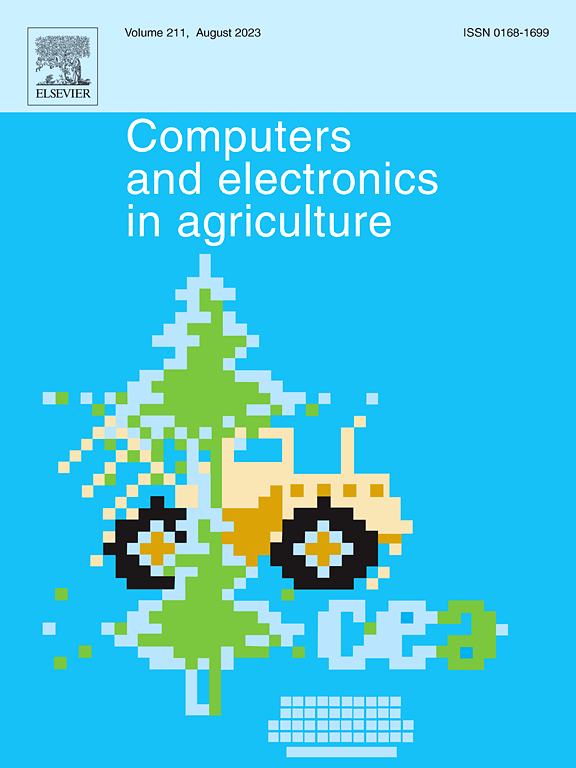UAV - nerf:基于无人机图像神经辐射场的果园三维重建与果树语义分割
IF 8.9
1区 农林科学
Q1 AGRICULTURE, MULTIDISCIPLINARY
引用次数: 0
摘要
在精准农业中,果园环境的精确三维重建对于作物健康监测和自动化农业任务至关重要。本文介绍了一种利用无人机对果园场景进行高保真三维重建和语义分割的新方法uavoo - nerf。为了解决大规模户外环境中的低效率问题,我们采用了非线性场景参数化,将无界场景压缩到立方空间中,从而可以对远距离点进行更密集的采样。我们实现了多分辨率哈希编码来捕获全局上下文和局部细节,显著提高了重建速度和质量。为了处理光照变化,我们结合了自适应编码光照条件的外观嵌入,增加了模型在不同光照下的鲁棒性。我们的网络输出层包括一个3D语义分割模块,该模块使用交叉熵损失函数来衡量预测和实际语义标签之间的差异,将果树与背景元素区分开来。深度预测精度通过预训练的单目深度估计模型生成的深度图来提高,通过结合重建、深度、语义、可见性和层间损失的复合损失函数来改进,以最大限度地减少人工影响并增强几何表征。实验结果表明,uvoo - nerf的峰值信噪比(PSNR)为23.82,在PSNR、结构相似指数测量(SSIM)和学习感知图像斑块相似度(LPIPS)等指标上优于即时- ngp和Mip-NeRF 360等最先进的模型。此外,uav - nerf在新视点的果树语义分割中,平均mIoU为0.891,比传统2D模型高出5%以上。这种方法为数字孪生在农业中的应用提供了一个强大的技术解决方案。本文章由计算机程序翻译,如有差异,请以英文原文为准。
UAVO-NeRF: 3D reconstruction of orchards and semantic segmentation of fruit trees based on neural radiance field in UAV images
In precision agriculture, accurate 3D reconstruction of orchard environments is essential for crop health monitoring and automating agricultural tasks. This paper introduces UAVO-NeRF, a novel method using Unmanned Aerial Vehicles (UAVs) for high-fidelity 3D reconstruction and semantic segmentation of orchard scenes. To address inefficiencies in large-scale outdoor environments, we employ a nonlinear scene parameterization that compresses the unbounded scene into a cubic space, enabling denser sampling of distant points. We implement multi-resolution hash encoding to capture both global context and local details, significantly enhancing reconstruction speed and quality. To handle lighting variability, we incorporate appearance embeddings that adaptively encode lighting conditions, increasing the model’s robustness under diverse illumination. Our network’s output layer includes a 3D semantic segmentation module that distinguishes fruit trees from background elements, using a cross-entropy loss function to measure the difference between predicted and actual semantic labels. Depth prediction accuracy is improved using depth maps generated by a pre-trained monocular depth estimation model, refined through a composite loss function that combines reconstruction, depth, semantic, visibility, and interlevel losses to minimize artifacts and enhance geometric representation. Experimental results demonstrate that UAVO-NeRF achieves a Peak Signal-to-Noise Ratio (PSNR) of 23.82, outperforming state-of-the-art models like Instant-NGP and Mip-NeRF 360 across metrics such as PSNR, Structural Similarity Index Measure (SSIM), and Learned Perceptual Image Patch Similarity (LPIPS). Additionally, UAVO-NeRF achieves a mean Intersection over Union (mIoU) of 0.891 for fruit tree semantic segmentation from novel viewpoints, exceeding traditional 2D models by over 5%. This approach offers a robust technological solution for digital twin applications in agriculture.
求助全文
通过发布文献求助,成功后即可免费获取论文全文。
去求助
来源期刊

Computers and Electronics in Agriculture
工程技术-计算机:跨学科应用
CiteScore
15.30
自引率
14.50%
发文量
800
审稿时长
62 days
期刊介绍:
Computers and Electronics in Agriculture provides international coverage of advancements in computer hardware, software, electronic instrumentation, and control systems applied to agricultural challenges. Encompassing agronomy, horticulture, forestry, aquaculture, and animal farming, the journal publishes original papers, reviews, and applications notes. It explores the use of computers and electronics in plant or animal agricultural production, covering topics like agricultural soils, water, pests, controlled environments, and waste. The scope extends to on-farm post-harvest operations and relevant technologies, including artificial intelligence, sensors, machine vision, robotics, networking, and simulation modeling. Its companion journal, Smart Agricultural Technology, continues the focus on smart applications in production agriculture.
 求助内容:
求助内容: 应助结果提醒方式:
应助结果提醒方式:


